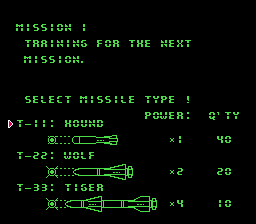Game flow[edit]
Your mission is to fly the F-14 Tomcat and to destroy the nuclear missiles in enemy territory. An enemy plane attacks your F-14 shortly after take off from the aircraft carrier, Enterprise. You must dodge the attack, and mount a counter-attack to destroy the enemy plane. When your mission is over, you must fly back to the Enterprise and land. To land safely on the deck you must stabilize the F-14 by paying close attention to the aircraft controls. If you fail, you will crash into the sea!
Mission breakdown[edit]
- Combat Level One is an introduction to dogfighting.
- Combat Level Two is a battle against enemy Naval forces.
- Combat Level Three sends you into battle against enemy ground forces.
- Combat Level Four is the ultimate battle in the air.
Non-fighting sequences[edit]
This game has the challenges of airborne refueling and landing on the aircraft carrier flight deck.
Missile Selection[edit]

Before each mission begins, you must select which type and quantity of missiles to stock on your plane. There are three different types of missiles to choose from, ranging in size. The bigger the missile, the more damage it does with each hit. However, bigger missiles weigh more, so your plane will be equipped with less of them.
The T-11 Hounds are the smallest and weakest missiles. However, because they are so light, you are equipped with 40 of them. The T-22 Wolf missiles are a middle strength weapon. They do medium damage, and you will be loaded with 20. The most powerful missile of all, not to mention heaviest, is the T-33 Tiger. These do the most damage, twice as much as the Wolf. However, due to their weight, you may only carry 10 of these at a time. Whenever you refuel in the middle of your mission, you are also provided with a full stock of missiles.
Landing[edit]

When you return to the aircraft carrier, control your air sped to make a successful landing. You'll get 10,000 bonus points if you land safely. Failure to land, however, will cost you one of your lives. Landing can be very frustrating for new players, and may take a few practice tries before you get it right.
Your multi-monitor will switch from radar mode to a side view perspective on your plane. Messages will appear above this image, providing advice such as "Left! Left!" or "Speed Up!". Listen to the advice by adjusting the position and speed of your plane. Below the image of your plane is a reminder that the best altitude to approach your plane is 200 feet, and the best Speed to be flying at is 288 miles per hour. Completing the approach takes roughly one minute. Depending on your performance, you may come in too fast or high and miss the runway, or you may come in to slow or low and crash into the water. If you succeed in bringing your plane in on a good approach, you will be treated to a successful landing animation and receive the bonus.
Refer to the following table to learn how to properly respond to the messages.
Refueling[edit]

Your first refueling operation is in Combat Level Two and each time you refuel, your Missile supply will also be replenished. Refueling is similar to landing; you must follow a set of instructions to successfully dock the fuel nozzle to the nose of your aircraft. If you fail to pull this operation off, you will clearly run out of fuel and lose a life.
When you are low on fuel and hear beeping, press the ![]() button. Note that if you are currently being tailed by an enemy, initiating the refueling sequence will immediately chase them away. When the sequence begins, your multi-function monitor will switch to Radar 3. Your goal is to get the refueling nozzle to touch the very center of the × on the nose of your plane. Listen to the instructions to increase or decrease your speed and correct your position to bring the nozzle closer. The instructions are generally the same as above, except that an instruction of "Up!! Up!!" means that you should adjust the nose of your jet upward by pressing
button. Note that if you are currently being tailed by an enemy, initiating the refueling sequence will immediately chase them away. When the sequence begins, your multi-function monitor will switch to Radar 3. Your goal is to get the refueling nozzle to touch the very center of the × on the nose of your plane. Listen to the instructions to increase or decrease your speed and correct your position to bring the nozzle closer. The instructions are generally the same as above, except that an instruction of "Up!! Up!!" means that you should adjust the nose of your jet upward by pressing ![]() and "Down!! Down!!" means that you should press
and "Down!! Down!!" means that you should press ![]() . Once you succeed, your plane will get a full tank of fuel and a restock of your missiles.
. Once you succeed, your plane will get a full tank of fuel and a restock of your missiles.